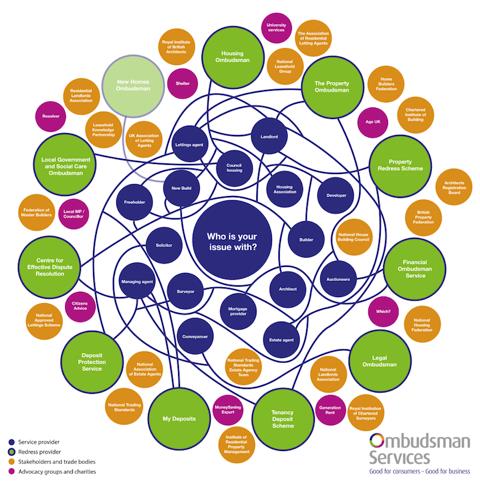The government is facing calls to simplify the housing complaints system, as new research illustrates the “baffling patchwork” of schemes involved
Ombudsman Services (OS), which is withdrawing from handling complaints in the housing and property sector next month, says the current redress process is too complex and confusing.
A diagram produced by the not-for-profit ombudsman shows there are nearly 40 services, charities, advice groups and trade bodies involved (see image below).
Matthew Vickers, chief ombudsman designate at Ombudsman Services, said: “Redress in the housing sector is far too complex, with overlaps and gaps that make it virtually impossible for consumers to get complaints resolved.
“Our research shows the vast and baffling patchwork of schemes that people are faced with when they have an unresolved complaint. The current system is fragmented, complicated and ineffective. Consumers deserve better.”
OS is urging the government to introduce a single ombudsman for the housing sector – an idea that was put forward in a Ministry of Housing, Communities & Local Government consultation earlier this year.
“By following the model used in energy, where strong regulation is backed up by a single ombudsman and effective advocacy, redress in housing could be transformed for the better,” said Vickers.
“Our research shows that the vast majority of the public support this approach.”
The All-Party Parliamentary Group for Excellence in the Built Environment has recommended the creation of a New Homes Ombudsman and a single consumer portal, which would signpost consumers to multiple redress schemes.
OS claims that the creation of such a portal would fail to address the fundamental problems with the current system.
“The approval of new schemes and portals in the sector would add more layers of complexity to a system that is already failing consumers,” added Vickers.
“The government must take action to reduce confusion and detriment.”
In a recent OS survey, seven in 10 respondents said they found the current system for making a housing complaint confusing, while more than half (55%) didn’t know where or how to complain.














